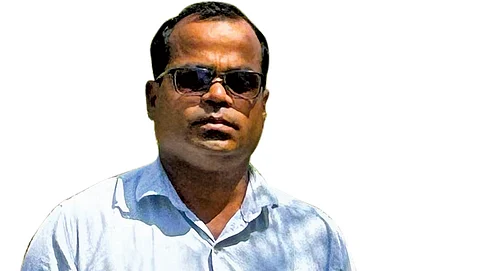

In the heart of Bhadalwadi village in Maharashtra’s Pune district, amid vast sugarcane fields, lies a farm that challenges conventional agriculture. “It looks more like a tiny forest and less like a farm,” admits Ramkrushna Yekale, a resident of the village known for its dominance in sugarcane production. Yekale, a primary school teacher and environmental advocate, has transformed this nearly 2-hectare farmland into a thriving sanctuary for birds and biodiversity.
Yekale’s journey began in 2019 out of concern for the declining bird population in his area. The construction of the Pune-Solapur highway had led to the removal of many banyan trees, stripping away crucial habitats for native birds. Determined to counteract this loss, Yekale, who has been associated with various bird conservation groups for almost two decades, decided to plant 62 banyan trees strategically on his farm to create dense nesting areas, particularly for species like the Rosy Starling that were vanishing rapidly.
“In the beginning, others criticised my decision to abandon sugarcane farming, especially since we are in Maharashtra’s prominent sugar-producing region. Even at base prices, I would earn Rs 8 lakh a year from sugarcane,” recalls Yekale. Despite challenges, including severe drought-like conditions in 2019 that necessitated costly water tanker deliveries to sustain his young trees, Yekale remained resolute in his mission. “I could do it because my primary source of income comes from teaching at a government school near the village,” he says.
Today, his farm showcases over two hundred varieties of indigenous trees, such as neem, sacred fig, palash and tamhan, interspersed with fruit-bearing trees such as mango, guava, and custard apple. The farm is also frequented by flocks of Indian courser, partridge, Indian nightjar, black drongo and other bird species. Beyond revitalising bird habitats, Yekale says his initiative is also addressing climate change by expanding green cover in an area dominated by sugarcane monoculture. He warns of the escalating threat posed by rising temperatures and the diminishing local water sources, which imperil both wildlife and the fragile ecological balance vital for human survival.
Yekale’s dedication has not gone unnoticed. His “human-made jungle” has become a source of inspiration for local schools and bird enthusiasts alike, attracting visits from curious students and passionate bird watchers. Looking forward, Yekale envisions his farm evolving into a hub for bird watching and a seed bank.
This article was originally published in the July 16-31, 2024 print edition of Down To Earth